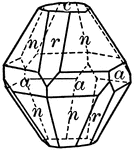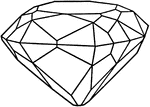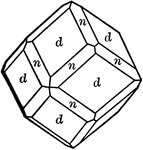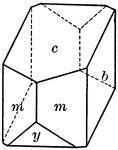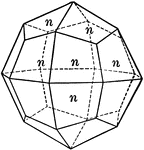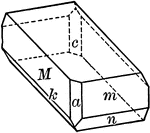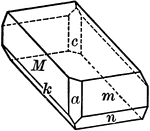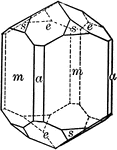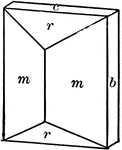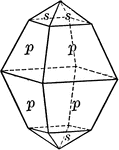
Compound Twinning
This figure shows an example of Compound Twinning, where two orthoclase twins are twinned in parallel…
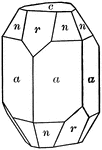
Corundum
"Hexagonal-rhombohedral. Crystals usually prismatic in habit or tapering hexagonal pyramids." —…

Corundum
"Hexagonal-rhombohedral. Crystals usually prismatic in habit or tapering hexagonal pyramids." —…
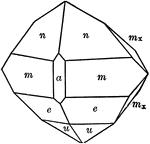
Datolite
"Monoclinic. Habit varied. Crystals usually nearly equidimensional in the three axial directions and…

Diopside
Diopside is a monoclinic pyroxene mineral with composition MgCaSi2O6. It forms complete solid solution…

Dioptase
Dioptase is an intense emerald-green to bluish-green copper cyclosilicate mineral. It is transparent…
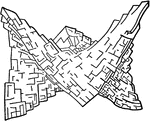
Dolomite
"Hexagonal-rhombohedral. Crystals are usually the unit rhombohedron (cleavage rhombohedron). Faces often…

Elongation in the Direction of the Clinodiagonal Axis
In cases where the basal pinacoid is fixed by some physical property like cleavage, the elongation is…

Epidote
"Monoclinic. Crystals are often much elongated parallel to the ortho-axis with a prominent development…
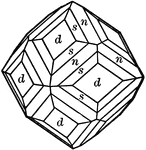
Garnet
"Isometric. Common forms dodecahedron amd trapezohedron, often in combination. Hexoctahedron observed…

Goethite
Goethite is a mineral composed of an iron hydrate crystallizing in soil and other low temperature environments.
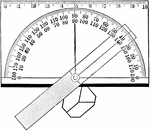
Contact Goniometer
"An important part of the study of crystallography consists in the measuring and classifying of the…
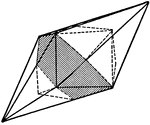
Green Fluorspar from Saxony
Certain crystals of green fluorspar from Saxony, showing the form ∞ 03, {310}, have one half of their…
Gypsum
"Monoclinic. Crystals usually tabular parallel to clinopinacoid; in diamond-shaped crystals with edges…

Hematite
"Hexagonal-rhombohedral. Crystals usually thick to thin tabular. Basal planes prominent, often showing…
Hematite
"Hexagonal-rhombohedral. Crystals usually thick to thin tabular. Basal planes prominent, often showing…
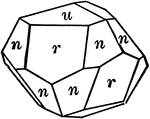
Hematite
"Hexagonal-rhombohedral. Crystals usually thick to thin tabular. Basal planes prominent, often showing…

Hornblende
Hornblende is a complex inosilicate series of minerals. Hornblende is not a recognized mineral in its…
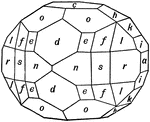
Hypersthene
This figure exhibits a combination occurring on the ferro-magnesian meta-silicate, Hypersthene. Forms:…

Magnetite
"Isometric. Octahedral habit, sometimes twinned octahedrons. Dodecahedron at times, either alone or…

Malachite
The most common twinning plane is the orthopinacoid ∞P∞̄ , {100}, as may be seen in this example…

Marcasite
"Orthorhombic. Crystals commonly tabular parallel to basal plane, showing also short prisms and low…
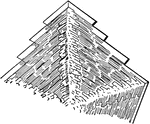
Marcasite
"Orthorhombic. Crystals commonly tabular parallel to basal plane, showing also short prisms and low…
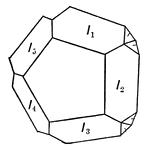
Marcasite
Orthorhombic Iron Disulphide (Marcasite) sometimes shows cyclic groups of five individuals, bounded…
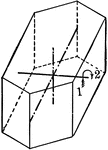
Symmetry of monoclinic system
"The symmetry of the Monoclinic System is as follows: The crystallographic axis b is an axis of binary…
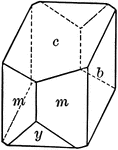
Orthoclase
"Monoclinic. Crystals are usually prismatic in habit and have as prominent forms, clinopinacoid, base,…

Orthoclase
"Monoclinic. Crystals are usually prismatic in habit and have as prominent forms, clinopinacoid, base,…

Quartz
"Terminated usually by a combination of a positive and negative rhombohedron, which often are so equally…

Quartz
"Terminated usually by a combination of a positive and negative rhombohedron, which often are so equally…
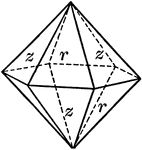
Quartz
"Terminated usually by a combination of a positive and negative rhombohedron, which often are so equally…

Quartz
This illustration shows Quartz or Silica. Quarts is the most abundant mineral in the Earth's continental…

Right-handed quartz
"The quartz crystals are said to be right or left handed, depending upon whether these faces are to…

Rhodonite
An alternate combination of manganese meta-silicate (Rhodonite), showing forms: (c), (b), (a), (n),…

Scalenohedron
"This form consists of twelve scalene triangular faces. These faces correspond in their position to…

Scapolite
"A crystal of scapolite, upon which the faces of the third-order pyramid are shown." — Ford, 1912

Scheelite
"Tetragonal; tri-pyramidal. Crystals usually simple pyramids of first order. Closely resemble isometric…
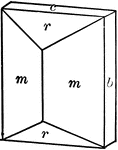
Staurolite
"Orthohombic. Habit prismatic, showing usually a combination of prism with large angle, brachypinacoid,…

Stilbite
"Monoclinic. Uniform in cruciform twins. Commonly tabular parallel to clinopinacoid. Crystals usually…
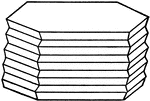
Striation of Crystal Planes
Striation of crystal planes may be produced by repeated polysynthetic twinning. This is well illustrated…

